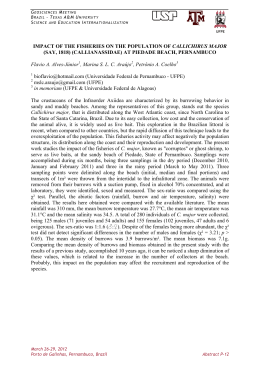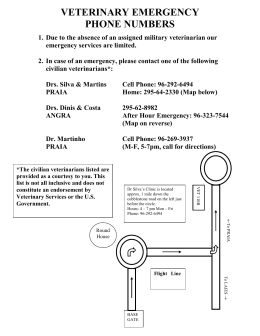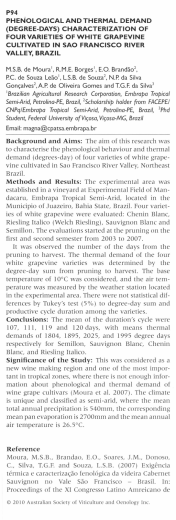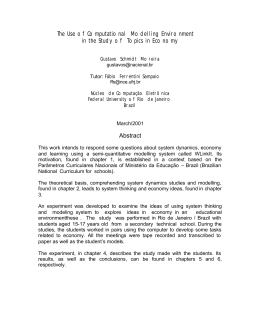Journal of Coastal Research 1165 - 1168 SI 39 ICS 2004 (Proceedings) Brazil ISSN 0749-0208 Population Structure of Callichirus Major (Say 1818) (Crustacea: Thalassinidea) in a Sandy Beach of Rio de Janeiro State, Southeast Brazil Coast. D. S. Simão†; M. F. Ramos† and A. Soares-Gomes† †Universidade Federal Fluminense, Departamento de Biologia Marinha, 24001-970 , P.O. Box 100.644 , Niterói , Rio de Janeiro, Brazil; [email protected] , [email protected] , [email protected] ABSTRACT SIMÃO, D.S.; RAMOS, M.F. and SOARES-GOMES, A., 2006. Population structure of Callichirus major (Say 1818) (Crustacea: Thallasinidea) in a sandy beach of Rio de Janeiro State, southeast Brazil coast. Journal of Coastal Research, SI 39 (Proceedings of the 8th International Coastal Symposium), 1165 - 1168. Itajaí, SC, Brazil, ISSN 0749-0208. The crustacean Callichirus major occurs along the Atlantic coast of the American continent, from North Carolina, o o USA (Lat.42 N) to Santa Catarina, Brazil (Lat.27 S). It lives in deep burrows in intertidal and sublittoral regions of fine sandy and sandy-mud shores, occurring with great abundance in Brazilian dissipative beaches. The beach Praia Rasa is located in Búzios municipality, northern Rio de Janeiro coast. Samples were collected monthly from November 2002 through September 2003 during low spring tides, at two stations. Population density at each station was estimated by counting burrows in 30 quadrats of 1m2, within an area of 400m2. Determination of sex-ratio and body parameters was done collecting 30 individuals from station 1, using a suction pump. Dimorphism of the chelipod was used for sex determination. The wet weight (WW), total length (TL), and dorsal oval length (DOL) were determined separately for males and females. Mean density from January to September was 12.97±8.5 -2 -2 burrows.m and 47.66±23.623 burrows.m at station 1 and 2, respectively (p<0.05, Kruskal-Wallis ANOVA). Means and standard deviation for total length, dorsal oval length and wet weigh of all individuals collected were: 6.68±1.78cm, 9.72±2.24mm, and 2.20±1.51g, respectively. Statistic differences between monthly means were also observed for all parameters considered. When compared to previous studies done in Brazil, the population density of C. major from Praia Rasa was higher than those reported from São Paulo and Paraná beaches, southern Brazil, whereas DOL showed similar results. Female/Male ratio was higher in our study than previously reported in Brazil. ADDITIONALINDEX WORDS: Ghost shrimp, autoecology, macrobenthos, dissipative beach. INTRODUCTION Sandy beaches are transitional habitats between land and seas with worldwide occurrence, what makes them suitable for comparative ecological studies (SCAPINI, 2003). Tourism, fishery, urbanization, mining on coastal areas the human wastes, and chemical residues from industries are impacting beach environment. These facts demand strategies to preserve such ecosystems. Among others, autoecological studies of dominant species, such as sandy crabs and ghost shrimps, are critical to propose sustainable management techniques for such natural areas. The decapod thalassinid Callichirus major occurs along the western Atlantic coast of the American continent, from North o o Carolina, USA (Lat. 42 N) to Santa Catarina, Brazil (Lat. 27 S) (RODRIGUES and SHIMIZU, 1997). Callichirus major lives in deep burrows at intertidal and sublittoral regions of fine sandy and sandy-mud shores, being Figure 1. Localization of Rio das Ostras - cabo Búzios embayment showing the studied beach. Journal of Coastal Research, Special Issue 39, 2006 1166 Simão et al. Figure 2. Beach profiles of stations 1 and 2 showing the zone of occurrence of C. major (in black). abundant in dissipative beaches. The burrows of this thalassinid are reasonably stable, allowing water to penetrate deep into the sediment column, which, in conjunction to their bioturbation activities, changes the sedimentary environment (e.g. oxygenation, mineralization, and biogeochemistry), influencing the structure of beach communities (SOUZA et al., 1998). Moreover, this species is a potential pollution indicator, due to its long life cycle and feeding behaviour, as recently suggested by SHIMIZU and ROSSO (2000), while studying some aspects of this species after an accidental oil spillage. Despite the importance of this species in beach ecosystems, few information can be found concerning their autoecology along the Brazilian coast, with the exceptions of São Paulo and Paraná coasts (SOUZA et al., 1998; RODRIGUES, 1985; RODRIGUES, 1971; SHIMIZU and RODRIGUES, 1998). The present study was designed to contribute to the study of the temporal distribution and population structure of C. major at Praia Rasa. STUDY AREA Praia Rasa is located at Armação dos Búzios municipality, o o o northern Rio de Janeiro coast (-22 43'N; -22 46'S; -41 58'W; o 41 54'E) (Figure 1). This beach represent part of the Rio das Ostras - cabo Búzios embayment, and shows a morphodynamic gradient with reflective characteristics towards the north and dissipative ones towards the south (FERNANDEZ and MUEHE, 1998; BENTES et al., 1997) (Figure 1). This study was carried out at the dissipative portion of this gradient, where C. major is the most conspicuous macrobenthic component. Human settlements in this portion of the beach are inexpressive although some fishing pressure exists on local thalassinid population. MATERIAL AND METHODS Two stations, arbitrarily named 1 and 2, were located 1km and 2km, respectively, from Una river. Beach profiles were determined at both stations using the Emery's profiling technique (EMERY, 1961), during an extreme low water spring tide in July. Thirty individuals were collected monthly at station 1, from November 2002 through August 2003 at low spring tides, using a suction pump (a model similar to that described by HAILSTONE and STEPHENSON, 1961). For determined the sexratio (male/female), length and wet-weight (WW).From January to September 2003, the density of C. major individuals 2 was estimated within an area of 400 m counting burrow 2 openings in 30 aluminium frames of 1 m . These were placed at random with the aid of random numbers table. Individuals were Figure 3. Monthly mean densities and standard deviations (SD) of C. major at stations 1 and 2. Journal of Coastal Research, Special Issue 39, 2006 Population Structure of Callichirus Major in a Sandy Beach of Rio de Janeiro State, Southeast Brazil Coast. 1167 Table 1. Results of analysis of variance by ranks (Kruskal-Wallis) and parametric ANOVA to test differences of mean densities between months. Station Statistical test Test value P value 1 Kruskal-Wallis 44.892 < 0,0001 2 ANOVA 6.622 < 0,0001 fixed in 4% formalin and then preserved in 70% hydrated alcohol. Sex was determined by the dimorphism of the chelipod (SOUZA et al., 1998). Length was expressed both by the total length (TL), measured the rostrum to the telson extremities and the dorsal oval length (DOL), measured from the rostrum to the end of concavity present in the cephalotorax. Statistical significances for monthly mean variation of density, WW, DOL and TL were tested by ANOVA. Data was also checked for normality (Kolmogorov and Smirnov test) and homogeneity of its variances (Bartellet test) before ANOVA. Kruskall-Wallis ANOVA test was performed whenever distribution was not normal even after transformation. The Chisquare test was used to test if sex distribution against 1:1 male/female ratio. RESULTS The beach profile of station 1 was wider and steeper than station 2. The zone of occurrence of C. major was wider at station 2 than station 1 (74 m and 60 m, respectively) (Figure 2). Mean population density from January to September 2003 was 12.97 ± 8.5 burrows.m-2 (ranging from 0 to 38 burrows.m-2 -2 N=270) and 47.66 ± 23.623 burrows.m (ranging from 0 to 104 -2 burrows.m N=269) at station 1 and 2, respectively. The mean density between the two stations was statistically different (Mann-Whitney test = 6849.0 p<0,0001) (Figure 3). Mean monthly densities were also statistically different, both at station 1 (p<0,0001, Kruskal-Wallis test= 62.062) and at station 2 (p<0,0001, ANOVA= 7,134) (Table 1). The means of the body parameters measured were statistically different between the studied months. The mean wet weigh was 2.20 ± 1.51 g (N=285), ranging from 0.10 g to 7,52 g; the mean total length was 6.68 ± 1.78 cm (N=278), ranging from 2.7 cm to 9.8 cm; and the mean dorsal oval length was 9.72 ± 2.24 mm (N=283), ranging from 4.0 mm to 13.7 mm. Differences between months were observed for all cited body parameters and the post hoc results are shown in Table 2. Means of TL, DOL, and wet weight of females were 7.30 ± 1.60 cm (N=105), 10.43 ± 1.91 mm (N=106), and 2.48 ± 1.49 g (N=106), respectively, and for males, TL was 7.02 ± 1.51 cm (N=58), DOL was 10.44 ± 2.02 mm (N=61), and wet weight was 2.52 ± 1.66 g (N=60). The correlation between TL and DOL was statistically significant for males and females (N=122, r=0,85 and N=265, r =0,94, respectively). The ovigerous females ranged from 0 to 10 individuals in November 2002 (Figure 4). According to the Chi-Square test the sex-ratio of some samples fitted in 1:1 while the remaining Months with different means according to post-hoc comparison Jan- Feb Feb- Mar/ Jun /Aug Mar- Jun Jan- Aug Feb- Aug Mar- Apr/ Jul samples differred from 1:1 (Table 3). DISCURSSION The variation in the width of the zone of occurrence of C. major between the two stations can be attributed to differences in the beach profiles. Beaches which exhibit flatter profile have more compact sediments, low permeability and, as a consequence, present a narrow swash zone (RAFFAELLI and HAWKINS, 1996) and water saturation zone. Furthermore, more compacted sediments are harder to burrow and should harbour low density populations. These theoretical considerations seem to apply to both studied stations at Praia Rasa: station 1 has a flatter profile, showing a narrow zone of occurrence of C. major and lower densities of burrows when compared to station 2. The maximum density of burrows of C. major at Praia Rasa during the studied period was about five folds the maximum densities found by SOUZA et al. (1998), at Paraná State, and by SHIMIZU and ROSSO (2000), at São Paulo State. When comparing the means rather than the extreme values, Praia Rasa also showed higher densities, mainly in comparison to São Paulo beaches. The mean density of Atami beach (Paraná) was about 10 ± 4 and at Praia Rasa was 13 ± 8 at station 1. SOUZA et al. (1998) and SHIMIZU and RODRIGUES (1998) emphasizes that the method consisting of counting opening burrows is efficient to estimate densities of C. major populations but may extrapolate these estimates, since burrows of others species can confuse or, on the other hand, be sub estimated since part of C. major population do not produce identifying openings (juveniles and low activity individuals). However, even considering a precision error of 20% in burrow counts at Praia Rasa the local density is more than two folds higher that found in other places. Nothing is known about the trophodynamics of the studied beaches however, as C. major is a suspensionfeeder, it could be speculated that a higher supply of food is provided for populations at Praia Rasa due to the enrichment of local waters by the coastal upwelling South Atlantic Central Waters (VALENTIN, 2001). The results of correlation between TL and DOL were statistically significant for males and females as observed in the work of SHIMIZU and RODRIGUES (1998) for all individuals. This correlation makes DOL a suitable parameter in measuring the corporal length. In fact, in some scenarios it may be a more precise estimate of individual length because it is well defined and quite more resistant than another parts of the carapace, which are easily damaged during collection with the suction pump (SHIMIZU and RODRIGUES, 1998). The means of DOL of Table 2. Results of analysis of variance by ranks (Kruskal-Wallis) and parametric ANOVA to test differences of mean values of body parameters between months. Variable Statistical test Test value P value Wet weight Kruskal-Wallis 37.60 < 0,0001 Total length Kruskal-Wallis 58.65 < 0,0001 Dorsal oval length Kruskal-Wallis 66.74 < 0,0001 Journal of Coastal Research, Special Issue 39, 2006 Post-hoc comparisons Nov- Jan Dec- Jan/Jul/Aug Jan- Feb/ Mar/Apr Mar- Jul/Aug Nov- Jun/ Jul/ Aug Dec- Jul Mar- Jun/ Jul/ Aug May- Jul Nov- Jan/ May/ Jun/ Jul/Ago Dec- Jun/ Jul Feb- Jul Mar- Jun/ Jul 1168 Simão et al. Table 3. Chi-square test results to detect departure from 1:1 sex-ratio. Months X 2 P value Fit 1:1 ratio Nov Dec Jan Feb Mar Apr May Jun Jul Aug 0.14 8.9 0.04 6.5 7 1.81 2.28 4.17 2.67 13.33 0.7 0.003 0.85 0.01 0.008 0.18 0.13 0.04 0.1 0.0002 Yes No Yes No No Yes Yes No Yes No this population during the studied period were approximately equal to the data obtained by SOUZA et al. (1998) (its means were approximately 10 mm in the lower intertidal zone and 12 mm in the upper intertidal zone, ranging from 7 to 14 mm). The mean values of DOL of C. major population at Praia Rasa are quite similar to that of São Paulo's coast. The modal distribution of DOL of C. major studied by SHIMIZU and RODRIGUES (1998) was 13 mm while the mean value of Rasa's beach populations was 10 mm. Our data revealed a higher number of females like studies of this species in Brazil. The data presented by SOUZA et al. (1998) showed that 63% of all individuals were females, and SHIMIZU and RODRIGUES (1997) obtained a sex ratio statistically different from 1:1 with a Chi-square result of 262.17 and p<0,001. FELDER and LOVETT (1989), HAILSTONE and STEPHENSON (1961) and TAMAKI et al. (1997) suggested that the predominance of adult females is a consequence of thalassinidean territorial behaviour, when males enter in other galleries to look for females. When two individuals meet in the same gallery, immediately after they fight and one ends mutilated or killed (RODRIGUES and SHIMIZU, 1997). ROWDEN and JONES (1994) also suggests that this predominance of females is a consequence of the strategy of collection which captures the individuals that are in the vertical axe of the gallery using as reference the burrow's opening. This method excludes the individuals in the ramification of its gallery, which are mainly males. The decrease in the number of ovigerous females from November 2002 to April 2003 and their further absence suggests a seasonal reproductive cycle. However a long-term survey is necessary before reaching to any conclusive statement. The seasonal reproductive cycle is a characteristic similar to other thalassinids (FELDER and LOVETT 1989; SOUZA et al., 1998; TAMAKI et al., 1997). AKNOWLEDGEMENTS The authors thanks Fabio Pitombo, Carla Mendes, Gabriela Benkendorfer, Rodrigo Brendolan, Sílvia Tardin, Simone Pennafirme, Bernardo Flores and Mariana Beauclair for helping in field works. The authors are indebted to Guilherme Fernandez for determination of beach profiles and special thanks to Carla Mendes and Marcelo Ramos for English reviewing. Figure 4. Monthly number of males, females and ovigerous females per month. LITERATURE CITED BENTES, A.M.L.; FERNANDEZ, G.B. and RIBEIRO, A.Y., 1997. Estudo da morfodinâmica de praias compreendidas entre Saquarema e Macaé, RJ. Oecologia brasiliensis, 3, 229-243. BORZONE, C.A. and SOUZA, J.R.B., 1996. A extração de corrupto (Callichirus major) para seu uso como isca em praias do litoral do Paraná. I Características da pesca. Nerítica, 10, 69-79. EMERY, K.O., 1961. A simple method for measuring beach profile. Limnol. Oceanogr., 6, 695-710. FELDER, D.L. and LOVETT, D.L., 1989. Relative growth and sexual maturation in the estuarine ghost shrimp Callianassa louisianensis Schmitt, 1935. J. Crust. Biol. 9, 540-553. FERNANDEZ, G.B. and MUEHE, D., 1998. A influência de sedimentos fluviais na morfologia da praia e antepraia no embaiamento Rio das Ostras Cabo de Búzios (RJ). Geosul, Florianópolis, 14(27), 200-203. GIANUCA, N.M., 1987. Zonação e produção nas praias arenosas do litoral sul e sudeste do Brasil: Síntese dos conhecimentos. I Simpósio sobre ecossistemas da costa sul e sudeste brasileira, (São Paulo, São Paulo, Brazil), 1, pp. 313-332. HAILSTONE, T.S. and STEPHENSON, W., 1961. The biology of Callianassa (Trypaea) australiensis Dana, 1852 (Crustacea, Thalassinidea). Pap. Dep. Zool. Univ.Ard., 1, 259-285. RAFFAELLI, D. and HAWKINS, S., 1996. Intertidal Ecology. London: Chapman & Hall. pp. 50-61. RODRIGUES, S.A., 1971. Mud shrimps of the genus Callianassa Leach from the Brazilian coast (Crustacea, Decapoda). Arquivos de Zoologia da Universidade de São Paulo, 20, 191-223. RODRIGUES, S.A., 1985. Sobre o crescimento relativo de Callichirus major (Say, 1818) (Crustacea, Decapoda, Thalassinidea). Boletim de Zoologia da Universidade de São Paulo, 9, 195-211. RODRIGUES, S.A. and SHIMIZU, R.M., 1997. Autoecologia de Callichirus major (SAY, 1818). Oecologia Brasiliensis, 3, 155-170. ROWDEN, A.A. and JONES, M.B. 1994. A contribution to the biology of the burrowing mud shrimp, Callianassa subterranean (Decapoda: Thalassinidea). J. Mar. Biol.Assoc. UK, 74, 623-635. SCAPINI, F., 2003. Beaches What Future? An integrated approach to the ecology of sand beaches. Estuarine, Coastal and Shelf Science. 58 (Special Issue), pp. 1-3. SHIMIZU, R.M. and RODRIGUES, S.A., 1998. Population ecology of Callichirus major (Crustacea: Decapoda: Thalassinidea) on a sandy beach in south-eastern Brazil. Proceeding of the Fourth International Crustacean Congress, Amsterdam, 311-322. SOUZA, J.R.B.; BORZONE, C. A. and BREY, T., 1998. Population dynamics and secondary production of Callichirus major (Crustacea: Thalassinidea) on a southern Brazilian sandy beach.Arch. Fish. Mar. Res., 46(2), 151-164. SOUZA, J.R.B. and GIANUCA, N.M., 1995. Zonation and seasonal variation of the intertidal macrofauna on a sandy beach of Paraná State, Brazil. Sci. Mar., 59, 103-111. TAMAKI, A.; INGOLE, B.; IKEBE, K.; MURAMATSU, K. and TAKA, M.,1997. Life history of the ghost shrimp, Callianassa japonica Ortmann (Decapoda: Thalassinidea), on an intertidal sandflat in western Kyushu, Japan. J.Exp. Mar. Biol. Ecol.,201, 223-250. VALENTIN, J.L., 2001. The Cabo Frio upwelling system, Brazil. In: SEELIGER, U. and KJERFVE, B. (eds.) Coastal Marine Ecosystem of Latin America. Berlin, Springer: Ecological Studies Serie, 144, pp. 97-105. Journal of Coastal Research, Special Issue 39, 2006
Download









